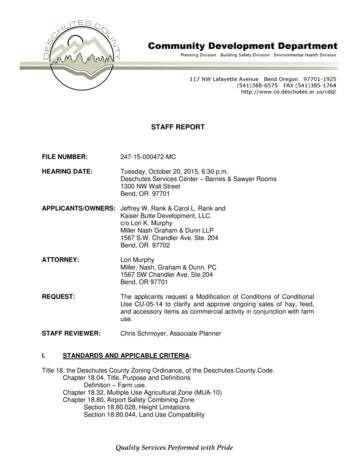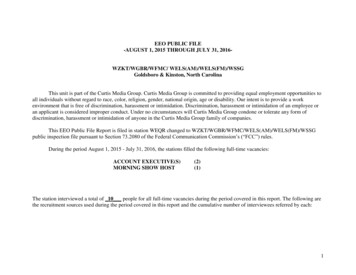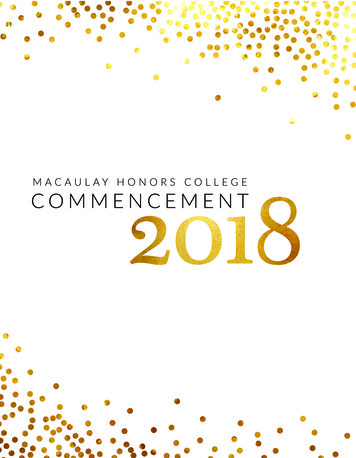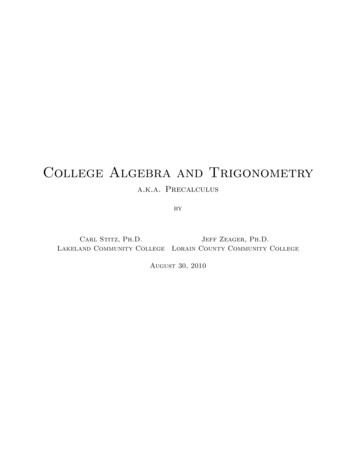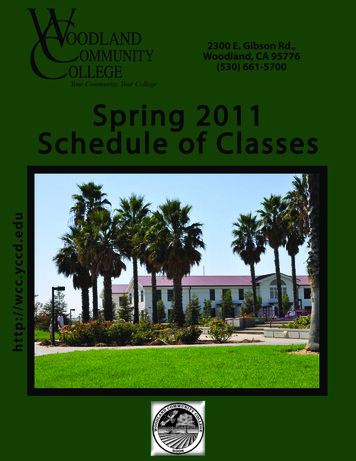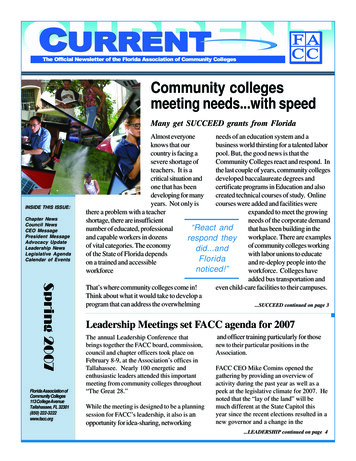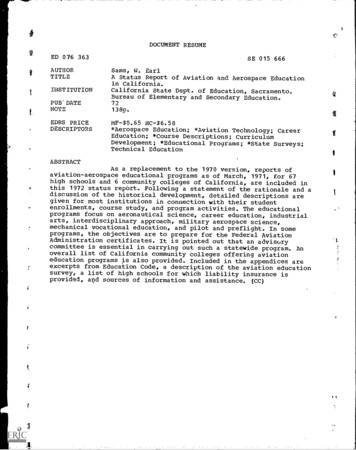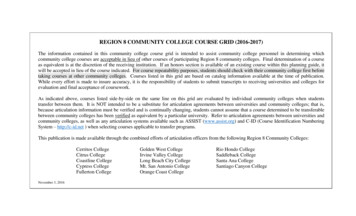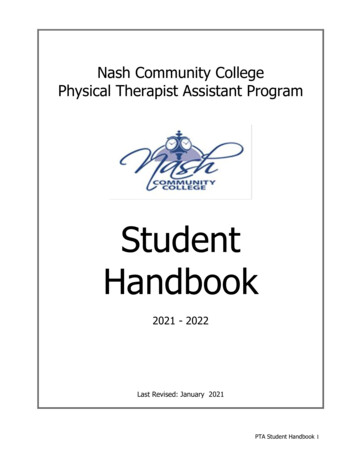
Transcription
Nash Community CollegePhysical Therapist Assistant ProgramStudentHandbook2021 - 2022Last Revised: January 2021PTA Student Handbook 1
Class of 2022Table of ContentsWelcome and Contact Information 3General Information Non-discrimination Statement . 3 Resource Information .4 Career Opportunities .5 Professional Advancement .5 Lifelong Learning .6 Exposure Risk . 6PTA Program Mission and Philosophy 6 Goals: Student and Program 7 Graduate Outcomes 8 Faculty Goals . 8 Technical Standards 9 Curriculum Sequence . 11 Student Responsibilities Adult Learner 12 PTA Program Space . 12 Class Scheduling 12 Social Networking . 13Admissions College Resources . 14 Program Costs 17 Financial Aid 18College Policies Student Conduct .20 Campus Photo and Video 20 Withdrawal 20Program Academic Policies20 Incomplete Grades . 21 Professional Behavior Policy .22 Attendance Policies . 23 Classroom and Laboratory Policies . 24 Examination Policies 25 Laboratory Competencies 25 Laboratory Guidelines & Safety 26Clinical Education . 27 Protected Health Information . 28 Student Health 29 Student Accident Insurance . 30 Expulsion Policy . 30 Readmission Policy . 31 Criminal Background and Drug Screen Due Process . 32Complaints Policies/Procedures for Processing Complaints . 33 Due Process . 33Personal Dress Code . 34AppendixA: New Student Orientation Checklist 35B: Information Release Consent Form .36C: Criminal Background and Drug Screen Consent Form .37D: Standards of Ethical Conduct for the PTA .38E: Entry-Level Competencies/Skills .41F: Minimum Required Skills of PTA Graduates at Entry-Level 44G: Value-Based Behaviors of the PTA (Self-Assessment) .52PTA Student Handbook 2
WELCOMEWelcome to the Nash Community College Physical Therapist Assistant (PTA) Program. We arepleased you have achieved your goal of admission and have selected this program to prepare youfor an exciting career as a PTA. Your chosen career requires significant academic preparation;therefore, class sizes are relatively small to maximize student instructor ratio to optimize practicalapplication and clinical experiences. Your attendance and active participation are essential foreffective learning. Success is dependent upon your willingness to take responsibility for learningboth academic and professional aspects of physical therapy. The PTA program challengesstudents both mentally and physically and requires a strong commitment to learning coupled withsignificant out of the classroom study time. The PTA Program faculty have a student-centeredapproach and are committed to providing a program of excellence and helping each studentlearner achieve the goal of becoming an outstanding PTA.The Student Handbook is designed and used in conjunction with the NCC College Catalog to helpeach student learner facilitate understanding of policies/procedures, rules and regulations of NashCommunity College (NCC) and the PTA Program. Some program policies may be more specificthan the NCC policies and in these cases, program policies take precedence. Please take time tofamiliarize yourself with these publications. Individual course syllabi provided at the start of eachcourse are a primary source of information from the instructor about the course, and may requiremodification at the discretion of the faculty. Although it can provide the answers too manyfrequently asked questions, please do not hesitate to ask a faculty or staff member forinformation. Each student learner will receive written notification of changes in policy, procedure,or practice as they occur.PTA PROGRAM CONTACT INFORMATIONDept. Chair Allied Health, Program Director,ACCE, Faculty InstructorAndrea Milks, PT, MS252-451-8481almilks594@nashcc.eduOffice: 2131Faculty Instructor, Co-ACCEStephen Tart, PTA, BS252-451-8338sdtart261@nashcc.eduOffice: 2122Health Sciences Admissions CoordinatorNicole c.eduOffice: 2130The Physical Therapist Assistant Program faculty is available during scheduled office hours, whichare posted outside their offices and within course syllabi.The student may scheduleappointments with the Program faculty outside of their scheduled office hours.NON-DISCRIMINATION STATEMENTNash Community College does not unlawfully discriminate in offering equal access to itseducational programs and activities or with respect to employment terms and conditions on thebasis of an individual’s race, color, national origin, sex, sexual orientation, gender, genderexpression, gender identity, genetic information, disability, age, religion, or veteran status.Nash Community College CatalogPTA Student Handbook 3
GENERAL INFORMATIONThe Nash Community College Physical Therapist Assistant Program is a five-semester curriculumthat prepares the student for a career as a Physical Therapist Assistant (PTA) through classroom,laboratory and clinical education. Upon successful completion of the program, the student willearn the Associate in Applied Science (AAS) in Physical Therapist Assistant degree. Each PTAstudent must pass the National Physical Therapy Examination (NPTE) for PTAs to be licenses inthe United States and practice as a physical therapist assistant. The Federation of State Boards ofPhysical Therapy (FSBPT) develops, maintains and administers the NPTE.The Southern Association of Colleges and Schools Commission on College (SACSCOC) accreditsthe College. The PTA program received accreditation by the Commission on Accreditation inPhysical Therapy Education (CAPTE) in 1989, and has reaffirmation review scheduled in 2021.The American Physical Therapy Association (APTA) is the professional organization for bothPhysical Therapists and Physical Therapist Assistants. As a physical therapist assistant student,you are eligible for membership in this organization, and will be required to join during theprogram’s technical phase.The State of North Carolina, through the North Carolina Board of Physical Therapy Examiners(NCBPTE) establishes and enforces the laws concerning the practice of physical therapy, approvesinitial licensure and renewal. The NCBPTE requires a licensure applicant to complete a fingerprintcheck for the FBI criminal background check. The details of the rules and regulations for PTAlicensure in North Carolina are discussed with student learners throughout the program. It isimportant to understand you are entering a profession that operates according to establishedcodes of conduct, both legal and ethical, and that by enrolling in this program each studentlearner becomes bound by those guidelines. Our program is not an isolated institution, but ratherpart of a nationwide “network” of physical therapy that involves not only individual practitionersbut also professional, state, and federal regulation. If a PTA student intends to seek licensureoutside of North Carolina, the college recommends you contact the appropriate state licensingagency to obtain the current requirements.RESOURCE INFORMATIONAPTA: American Physical Therapy Association, 1111 N. Fairfax St., Alexandria, VA 22314; 800999-2782; website: www.apta.orgCAPTE: Commission on Accreditation in Physical Therapy Education, 3030 Potomac Ave., Suite100 Alexandria, VA 22305-3085; 703-706-3245; e-mail: accreditation@apta.org; website:www.capteonline.orgFSBPT: Federation of State Boards of Physical Therapy, 124 West Street South, Third Floor,Alexandra, VA 22314; 703-299-3100; website: www.fsbpt.orgNCPTE: North Carolina Board of Physical Therapy Examiners, 8300 Health Park Suite 233,Raleigh, NC 27615; 800-800-8982; website: ncptboard.orgSACSCOC: Southern Association of Colleges and Schools Commission on Colleges, 1866 SouthernLane, Decatur, GA 30033-4097; 404-679-4500.PTA Student Handbook 4
CAREER OPPORTUNITIESPhysical therapist assistants (PTAs) provide physical therapy services under the supervision anddirection of a physical therapist (PT) in many different types of health care settings. The healthcare settings include hospitals, private clinics, rehabilitation centers, extended care facilities,home health agencies, and public school systems. Physical therapist assistants implementtreatments within a plan of care, collect data related to patient care and collaborate with the PTregarding patient status and progress. The PTA is a vital member of the healthcare team with aconsiderable degree of responsibility.PTAs assist the physical therapist in the treatment of persons across the lifespan from pediatricsto the elderly. Physical therapy professionals commonly work in settings where patients areseriously ill or injured. It is important for the PTA student to comprehend they will be treatingindividuals with a wide range of medical conditions and not just injuries. If you enrolled in the PTAprogram with the belief of only treating injured athletes, you will need to discuss this with a facultymember before progressing any further in the program.The college Career Center assists students in preparing for and pursuing meaningful andrewarding careers through a comprehensive array of programs and services. The services caninclude career planning, resume development, cover letters, interviewing skills, job searches andpotential placement. The college utilizes the search engine College Central Network Services thatallows students, alumni and community members to explore employment opportunities. Thecollege hosts Career Fairs connecting students and employers across a number of industrieswhere employers have the opportunity to recruit students, alumni and community members.Ongoing changes in the health care industry can make it challenging to predict job availability andsalary trends. PTA students have access to the APTA Career Center as the leading source forcurrent information. The Program Director shares job postings, opportunities and vacancies withPTA students and graduates as they become available.PROFESSIONAL ADVANCEMENTThe Physical Therapist Assistant earned degree does not serve as a pathway to become a physicaltherapist. If the ultimate goal is to become a physical therapist, Nash Community College canassist a student by providing college transfer courses towards Bachelor degree requirements.Graduation from a physical therapist assistant program does not guarantee future acceptance intoa physical therapy program. A student should talk with a faculty member for further questions, orconsult www.apta.org, for information about Physical Therapist educational programs.Each PTA student will be learning entry-level performance skills. Entry-level skills are necessaryfor a graduate physical therapist assistant (Appendix A). Once licensed, a therapist will be able todevelop advanced skills through participation in continuing education activities. Some examplesof advanced specialty skills a therapist may wish to pursue in the future are in sports therapy,pediatrics, and geriatrics. Some physical therapist assistants seek continuing educationopportunities that allow them to teach in Physical Therapist Assistant educational programs. APTA student can begin continuing education prior to graduation by participating in workshopsprovided by the APTA, the North Carolina chapter and local districts. Many of these programs areopen to student attendees, and often at discounted rates as a student member of the APTAprofessional organization.PTA Student Handbook 5
Physical Therapist Assistants can gain advanced proficiency knowledge and skill through the APTA inthe following areas: Acute Care Cardiovascular / pulmonary Geriatrics Oncology Pediatrics Wound ManagementLIFELONG LEARNINGThe PTA program objectives encourage participation in continuing education activities throughlifelong learning. In the State of North Carolina, only ethics and jurisprudence is required duringthe initial licensure period. After the initial license period, Physical Therapist Assistants arerequired to acquire documented twenty (20) hours of continuing Competence Credit (CEUs) forthe twenty-five (25) months that precede the licensure renewal month.EXPOSURE RISK IN HEALTH CARE PROFESSIONSStudents are at risk for exposure to blood and body fluids that may be contaminated with thehepatitis B virus, hepatitis C virus, human immunodeficiency virus (HIV), and other potentiallyharmful or contagious pathogens while in the clinical setting. Bloodborne pathogens and methodsto protect against associated exposure risks are taught before the student's first clinicalexperience. Education on Bloodborne pathogens and standard precautions may also be a part ofthe student's orientation to a clinical facility. It is important for students to always followstandard precautions to minimize the risk of exposure in a clinical setting.PROGRAM MISSIONThe Physical Therapist Assistant program at Nash Community College provides an affordableopportunity for students to gain the knowledge and skills, and develop the professional behaviorsnecessary, to earn the Associate in Applied Science degree in Physical Therapist Assistant. Theprogram exhibits dedication to developing graduates with an awareness of diversity who arecompetent and caring entry-level physical therapist assistants who will provide evidence-basedphysical therapy services under the direction and supervision of a physical therapist and arecommitted to lifelong learning.PROGRAM PHILOSOPHYThe Physical Therapist Assistant program supports the mission and goals of Nash CommunityCollege. The faculty promote high standards of ethics and professionalism as it strives to meetthe following commitments to students, the public and the College:1. To assist qualified students to meet their individual goal of becoming a Physical TherapistAssistant.2. To prepare individuals to competently practice physical therapy at the Associate Degreelevel.3. To serve the needs of the public by providing skilled, licensed physical therapy personnel.4. To contribute to fulfillment of the College mission by meeting the needs of its studentsand the surrounding communities.PTA Student Handbook 6
STUDENT GOALSStudents of the Physical Therapist Assistant program at Nash Community College will be able to:1. Communicate verbally, non-verbally, and in written form in an effective, respectful, andtimely manner in ways that congruent with situational needs.a. Indicatorsi. Clinical Performance Instrument Assessment scoring by Clinical Instructorii. Advisory Committee Feedback2. Identify, respect and act with consideration for patients’ / clients’ differences, valuespreferences, and expressed needs in all work related actualitiesa. Indicatorsi. Clinical Performance Instrument Assessment scoring by Clinical Instructorii. Advisory Committee Feedback3. Demonstrate retention in PTA first technical semestera. Indicatorsi. Percentage of academic failure to progress in the first technical semesterPROGRAM GOALSThe Physical Therapist Assistant program at Nash Community College will:1. Identify, recruit, and accept qualified applicants by providing accurate information tostudents and the public that is sufficient to make informed decisions.a. Indicatorsi. Program policies and procedures are supported by the College to meetstandards of the professionii. Graduation rates are at least 60% averaged over two years2. Provide an organized, contemporary and comprehensive curriculum integrating academicand clinical education experiences to prepare students as entry-level physical therapistassistants.a. Indicatorsi. Employ competent facultyii. Offer evidence based practice instructional tools and pedagogyiii. Offer diverse clinical site experiences3. Promote high academic, clinical and professional standards that foster the development ofproblem solving, critical thinking, and effective communication.a. Indicatorsi. Students demonstrate professional, competent and effective behaviors4. Graduate entry-level physical therapist assistants capable of gaining licensure andprepared to work safely and effectively in the best interest of the public under thedirection and supervision of a physical therapist as part of a dynamic healthcare team.a. Indicatorsi. Graduates demonstrate professional, ethical and safe behaviorsii. Ultimate licensure pass tares are at least 85%, averaged over two yearsPTA Student Handbook 7
GRADUATE GOALSGraduates of the Physical Therapist Assistant program at Nash Community College will be able to:1. Gain licensure and employment as an entry-level physical therapist assistant.a. Indicatorsi. Employment rates within one year of graduationii. Employer feedback2. Work collaboratively with physical therapy professionals and other healthcare providers ina variety of clinical settings in the best interest of the public.a. Indicatorsi. Stakeholders feedback (Advisory Committee, Employers, Colleagues)3. Demonstrate entry-level professional, safe, and effective physical therapy services underthe direction and supervision of a licensed physical therapist.a. Indicatorsi. Stakeholders feedback (Advisory Committee, Employers, Colleagues)4. Uphold the ethical and legal standards of the profession by complying with national andstate regulations regarding the practice of physical therapy in all practice settings.a. Indicatorsi. Licensure renewal ratesii. Stakeholders feedback (Advisory Committee, Employers, Colleagues)FACULTY GOALS1. Function as an integral part of the College by faculty participation in committeeassignments, professional development, and recruitment activities.a. Indicatorsi. Program faculty meet participation expectations as set by the Collegeii. Meet the state licensee’s continued competence requirements to augmentknowledge, skills, behaviors and abilities related to the practice of physicaltherapy2. Faculty model professional and ethical behaviors to students in both the academic andclinical settingsa. Indicatorsi. Demonstrate behaviors as indicated in course evaluationsii. Demonstrate behaviors as indicated in evaluations of clinical faculty andsitePTA Student Handbook 8
TECHNICAL STANDARDS OF PHYSICAL THERAPY EDUCATION:ADMISSION, RETENTION, AND GRADUATION STANDARDSStudents enrolled in the Physical Therapist Assistant (PTA) Program at Nash Community Collegemust demonstrate competence in various intellectual, physical and social aspects, whichrepresent the fundamentals of professional Physical Therapy practice upon graduation. The PTAcurriculum provides the general, technical and clinical education required to enable the student todeliver entry-level clinical services in an array of health settings. All students must meet theminimum criteria established by the Commission on Accreditation in Physi
The Nash Community College Physical Therapist Assistant Program is a five-semester curriculum that prepares the student for a career as a Physical Therapist Assistant (PTA) through classroom, laboratory and clinical education. Upon successful com
